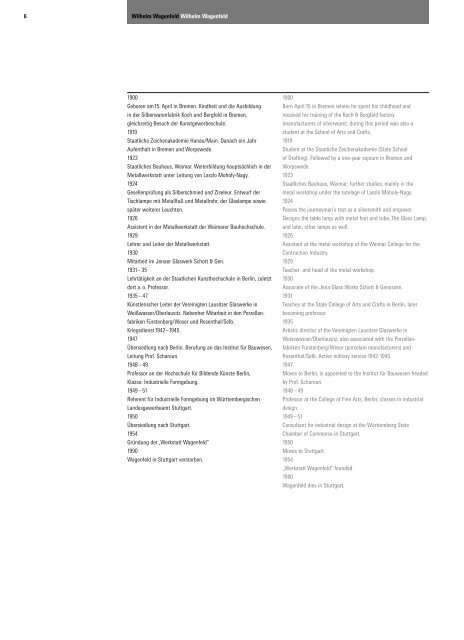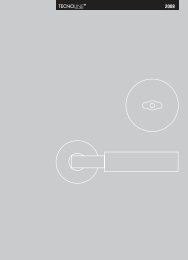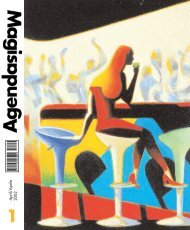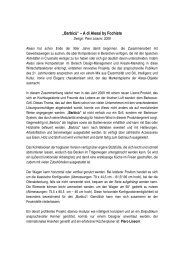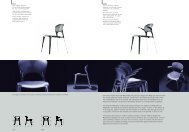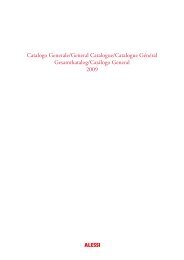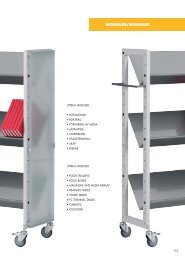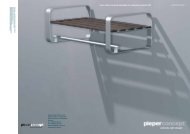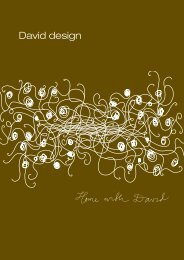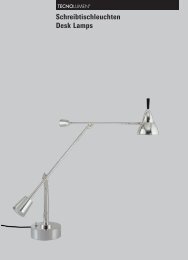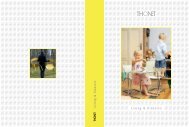TECNOLUMEN® 2.0 - adero Design
TECNOLUMEN® 2.0 - adero Design
TECNOLUMEN® 2.0 - adero Design
Sie wollen auch ein ePaper? Erhöhen Sie die Reichweite Ihrer Titel.
YUMPU macht aus Druck-PDFs automatisch weboptimierte ePaper, die Google liebt.
6 Wilhelm Wagenfeld Wilhelm Wagenfeld<br />
1900<br />
Geboren am15. April in Bremen. Kindheit und die Ausbildung<br />
in der Silberwarenfabrik Koch und Bergfeld in Bremen,<br />
gleichzeitig Besuch der Kunstgewerbeschule.<br />
1919<br />
Staatliche Zeichenakademie Hanau/Main. Danach ein Jahr<br />
Aufenthalt in Bremen und Worpswede.<br />
1923<br />
Staatliches Bauhaus, Weimar. Weiterbildung hauptsächlich in der<br />
Metallwerkstatt unter Leitung von Laszlo Moholy-Nagy.<br />
1924<br />
Gesellenprüfung als Silberschmied und Ziseleur. Entwurf der<br />
Tischlampe mit Metallfuß und Metallrohr, der Glaslampe sowie<br />
später weiterer Leuchten.<br />
1926<br />
Assistent in der Metallwerkstatt der Weimarer Bauhochschule.<br />
1929<br />
Lehrer und Leiter der Metallwerkstatt.<br />
1930<br />
Mitarbeit im Jenaer Glaswerk Schott & Gen.<br />
1931– 35<br />
Lehrtätigkeit an der Staatlichen Kunsthochschule in Berlin, zuletzt<br />
dort a. o. Professor.<br />
1935 –47<br />
Künstlerischer Leiter der Vereinigten Lausitzer Glaswerke in<br />
Weißwasser/Oberlausitz. Nebenher Mitarbeit in den Porzellanfabriken<br />
Fürstenberg/Weser und Rosenthal/Selb.<br />
Kriegsdienst1942–1945.<br />
1947<br />
Übersiedlung nach Berlin. Berufung an das Institut für Bauwesen,<br />
Leitung Prof. Scharoun.<br />
1948 – 49<br />
Professor an der Hochschule für Bildende Künste Berlin,<br />
Klasse: Industrielle Formgebung.<br />
1949 –51<br />
Referent für Industrielle Formgebung im Württembergischen<br />
Landesgewerbeamt Stuttgart.<br />
1950<br />
Übersiedlung nach Stuttgart.<br />
1954<br />
Gründung der „Werkstatt Wagenfeld“<br />
1990<br />
Wagenfeld in Stuttgart verstorben.<br />
1900<br />
Born April 15 in Bremen where he spent his childhood and<br />
received his training of the Koch & Bergfeld factory<br />
(manufacturers of silverware); during this period was also a<br />
student at the School of Arts and Crafts.<br />
1919<br />
Student at the Staatliche Zeichenakademie (State School<br />
of Drafting). Followed by a one-year sojourn in Bremen and<br />
Worpswede.<br />
1923<br />
Staatliches Bauhaus, Weimar; further studies, mainly in the<br />
metal workshop under the tutelage of Laszlo Moholy-Nagy.<br />
1924<br />
Passes the journeyman’s test as a silversmith and engraver.<br />
<strong>Design</strong>s the table lamp with metal foot and tube, The Glass Lamp,<br />
and later, other lamps as well.<br />
1926<br />
Assistant at the metal workshop of the Weimar College for the<br />
Contruction Industry.<br />
1929<br />
Teacher and head of the metal workshop.<br />
1930<br />
Associate of the Jena Glass Works Schott & Genossen.<br />
1931<br />
Teaches at the State College of Arts and Crafts in Berlin, later<br />
becoming professor.<br />
1935<br />
Artistic director of the Vereinigten Lausitzer Glaswerke in<br />
Weisswasser/Oberlausitz, also associated with the Porzellanfabriken<br />
Fürstenberg/Weser (porcelain manufacturers) and<br />
Rosenthal/Selb. Active military service 1942-1945.<br />
1947<br />
Moves to Berlin, is appointed to the Institut für Bauwesen headed<br />
by Prof. Scharoun.<br />
1948 – 49<br />
Professor at the College of Fine Arts, Berlin; classes in industrial<br />
design.<br />
1949 –51<br />
Consultant for industrial design at the Württemberg State<br />
Chamber of Commerce in Stuttgart.<br />
1950<br />
Moves to Stuttgart.<br />
1954<br />
„Werkstatt Wagenfeld“ founded.<br />
1990<br />
Wagenfeld dies in Stuttgart.


